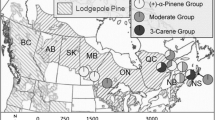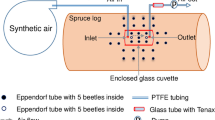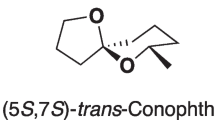Abstract
Chemical ecology of the spruce bark beetle Ips typographus (L.) was reviewed. The outbreak of I. typographus in central Europe triggered extensive research on chemical ecology. Males initiate host location and produce semiochemicals which attract both males and females. A successful mass attack must first overcome the resistance of the host tree. Pioneer I. typographus evolved to use the resin flow of host trees as kairomones in host location, and synthesized semiochemicals initially to detoxify the resin. If small bark beetle populations infest healthy trees, mass attack is prevented by host resistance. Nine monoterpene alcohols were found in male hind-guts, including cis-verbenol (cV) and 2-methyl-3-buten-2-ol (MB) which are regarded as primary aggregation pheromones, and a low proportion of Ipsdienol (Id) which increases attractiveness of cV and MB. Verbenone (Vn) and Ipsenol (Ie) are anti-aggregation pheromones, that play important roles in adjusting attack density and insect density under the bark. Non-host volatiles are repellent to I. typographus, so that beetles do not waste energy boring into non-host trees. The relationship between host resistance, pheromone compounds and behavior, non-host volatiles, bioassays and mass trapping are reviewed. Results of field bioassays stressed that traps baited with specific pheromones could be used as a reasonable protection measure.
Similar content being viewed by others
References
Alcock, J. 1982. Natural selection and communication among bark beetles [J]. Fla. Entomol., 65: 17–32.
Anderbrant, O., Schlyter, F., and Birgersson, G. 1985. Intraspecific competition affecting parents and offspring in the bark beetle Ips typographus [J]. Oikos, 45: 89–98.
Austarå, Ø., Bakke, A., and Midtgaard, F. 1986. Response in Ips typographus to logging waste odors and synthetic pheromones[J]. J. Appl. Ent., 101: 194–198.
Babuder, G., Pohleven, F. and Brelih, S. 1996. Selectivity of synthetic aggregation pheromones linoprx® and Pheroprax® in the control of the bark beetles (Coleoptera, Scolytidae) in a timber storage yard [J]. J. Appl. Ent., 120: 131–136.
Baier, P. 1996. Defence reactions of Norway spruce (Picea abies Karst.) to controlled attacks of Ips typographus (L.) (Col., Scolytidae) in relation to tree parameters [J]. J. Appl. Eng., 120: 587–593.
Bakke, A. 1970. Evidence of a population aggregating pheromone in Ips typographus (Coleoptera: Scolytidae) [J]. Contrib. Boyce Thompson Inst., 24: 309–310.
Bakke, A. 1976. Spruce bark beetle, Ips typographus: Pheromone production and field response to synthetic pheromones [J]. Naturwissenschaften, 63: 92.
Bakke, A., Fröyen, P., and Skatteböl, L. 1977. Field response to a new pheromone compound isolated from Ips typographus [J]. Naturwissenschaften, 64: 98–99.
Bakke, A., and Kvamme, T.K. 1978. Kairomone response by the predators Thanasimus formicarius and Thanasimus rufipes to the synthetic pheromones of Ips typographus[J]. Norw. J. Entomol., 25: 41–43.
Bakke, A. 1981. Inhibition of the response in Ips typographus to the aggregation pheromone: Field evaluation of verbenone and ipsenol [J]. Z. Angew. Entomol., 92: 172–177.
Bakke, A., and Kvamme, T. 1981. Kairomone response in Thanasimus predators to pheromone components of Ips typographus [J]. J. Chem. Eco., 7(2): 305–312.
Bakke, A. 1982. Mass trapping of the spruce bark beetle Ips typographus in Norway as a part an integrated control program [C] In: Kyedonius, A. F., Beroza, M. (eds), Insect suppression with controlled release pheromone systems II. Boca Raton, Florida: CRC Press. Pp. 18–25.
Bakke, A., Sather, T., and Kvamme, T. 1983. Mass trapping of the spruce bark beetle Ips typographus pheromone and trap technology [R]. Reports of the Norwegian forest research institute, 38(3): 1–35.
Bakke, A. 1983. Host tree and bark beetle interaction during a mass outbreak of Ips typographus in Norway [J]. Z. ang. Ent. 96: 118–125.
Bakke, A. 1987. Repression of Ips typographus infestations in Stored logs by semiochemicals [J]. Scand. J. For. Res., 2: 179–185.
Bakke, A., and Kvamme, T. 1993. Beetles attracted to Norway spruce under attack by Ips typographus [J]. Meddelelser fra Communications of Skogforsk, 45(9): 1760–1784.
Birgersson, G., Schlyter, F., Löfqvist, J., and Bergström, G. 1984. Quantitative variation of pheromone components in the spruce bark bettle Ips typographus from different attack phases [J]. Journal of Chemical Ecology, 10(7): 1029–1055.
Birgersson, G., Schlyter, F., BergstrÖm, G., and Löfqvist, J. 1988. Individual variation in aggregation pheromone content of the bark beetle, Ips typographus [J]. J. Chem. Ecol., 14(9): 1737–1761.
Birgersson, G. 1989. Host tree resistance influencing pheromone production in Ips typographus (Coleoptera: Scolytidae) [J]. Holarctic Ecology, 12: 451–456.
Borden, J.H. 1984. Semiochemical-mediated-aggregation and dispersion in the Coleoptera [C]. In: Lewis, T. (Eds.), Insect Communication. New York: Academic, pp 123–49.
Brignolas, F., Lieutier, F., Sauvard, D., Christiansen, E., and Berryman, A.A. 1998. Phenolic predictors for Norway spruce resistance to the bark beetle Ips typographus (Coleoptera: Scolytidae) and an associated fungus, Ceratocystis polonica [J]. Can. J. For. Res., 28: 720–728.
Byers, J.A. 1981. Pheromone biosynthesis in the bark bettle Ips paraconfusus, during feeding or exposure to vapours of host plant precursors [J]. Insect Biochem., 11: 563–569.
Byers, J.A. 1983. Sex-specific response to aggregation pheromone: Regulation of colonization density in the bark beetle Ips paraconfusus [J]. J. Chem. Ecol., 9: 129–142.
Byers, J.A. 1984. Nearest neighbor analysis and simulation of distribution patterns indicates an attack spacing mechanism in the bark beetle, Ips typographus (Coleoptera: Scolytidae) [J]. Environmental Entomology, 13: 1191–1200.
Byers, J.A. 1989. Behavioral mechanisms involved in reducing competition in bark beetles [J]. Holarctic Ecology, 12: 467–476.
Byers, J.A. 1993. Simulation and equation models of insect population control by pheromone-baited traps [J]. J. Chem. Ecol., 19(9): 1939–1956.
Byers, J.A. 1993. Avoidance of competition by spruce bark beetles, Ips typographus and Pityogenes chalcographus [J]. Experientia, 49: 272–275.
Byers, J.A., Zhang, Q.H., Schlyter, F., and Birgersson, G. 1998. Volatiles from nonhost birch trees inhibit pheromone response in spruce bark beetles [J]. Naturwissenschaften, 85: 557–561.
Christiansen, E., and Horntvedt, R. 1983. Combinet Ips/Ceratocystis attack on Norway spruce, and defensive mechanisms of the trees [J]. Z. Angew. Entomol., 96: 110–118.
Dickens, J. C. 1981. Behavioural and electrophysiological responses to the bark beetle Ips typographus to potential pheromone components [J]. Physiol. Entomol., 6: 251–261.
Dimitri, L., Gebauer, U., Lösekrug, R., and Vaupel, O. 1992. Influence of mass trapping on the population dynamic and damage-effect of bark beetles [J]. J. Appl. Ent., 114: 103–109.
Eidmann, H.H. 1983. Management of the spruce bark beetle Ips typographus in Scandinavia using pheromones [J]. Int. Congr. Plant Protection Brighton, 3: 1042–1050.
Fish, R.H., Browne, L.E., Wood, D.L. and Endry, L.B. 1979. Pheromone biosynthetic pathway: Conversions of deuterium labeled insedienol with sexual and enantioselectivity in Ips paraconfusus Lanier [J]. Tetrahedron Lett., 17: 1465–1468.
Francke, W., and Vite, J.P.Z. 1983. Oxygenated terpenes in pheromone systems of bark beetles Polygraphus poligraphus, Ips amitinus, Ips typographus [J]. Z. Angew. Entomol., 96: 146–56.
Hedgren, P.O., and Schroder, L.M. 2004. Reproductive success of the spruce bark beetle Ips typographus (L.) and occurrence of associated species: a comparison between standing beetle-killed trees and cut trees [J]. For. Ecol. Manag., 203: 241–250.
Hughes, P.R. 1974. Myrcene: A precursor of pheromones in Ips beetles [J]. Journal of Insect Physiological, 20: 1271–1275.
Jakuš, R., and Šimko, J. 2002. The use of dispensers with different release rates at pheromone trap barrier and in single traps [J]. J. Appl. Entomol., 126: 306–311.
Jakuš, R., and Blaženec, M. 2003. Influence of the proportion of (-) α-pinene in pheromone bait on Ips typographus (Col., Scolytidae) catch in pheromone trap barriers and in single traps [J]. J. Appl. Ent., 127: 91–95.
Krawielitzki, S., Klimetzek, D., Bakke, A., Vité, J. P., and Mori, K. 1977. Field and laboratory response of Ips typographus to optically pure pheromonal components [J]. Z. Angew. Entomol., 83: 300–302.
Leufvén, A., and BergstrÖm. 1987. Quantitative variation of different monoterpenes around galleries of Ips typographus (Colleoptera: Scolytidae) attacking Norway spruce [J]. Can. J. Bot., 65: 1038–1044.
Lindström, M., Norin, T., Birgersson, G., and Schlyter, F. 1988. Variation of enantiomeric composition ofα-pinene in Norway spruce, Picea abies, and its influence on the production of verbenol isomers by Ips typographus in the field [J]. J. Chem. Ecol., 13: 728–756.
Mills, N.J. 1985. Some observations on the role of predator in the natural regulation of Ips typographus populations [J]. Z. Angew. Entomol., 99: 209–320.
Niemeyer, H. 1997. Integrated bark beetle control: experiences and problems in Northern Germany [C]. In: Grégorire, J.C., Iiebhold, A.M., Stephen, F.M., Day, K.P. and Salom, S.M. (Eds), Proceedings: Integrating cultural tactics into the management of bark beetle and reforestation pests. USDA Forest Service General Technical Report NE-236, Pp. 80–86.
Raffa, K.F. and Dahlsten, D.L. 1995. Differential responses among natural enemies and prey to bark beetle pheromones [J]. Oecologia, 102: 17–23.
Ravn, H. P. 1985. Expansion of the populations of Ips typographus (L.) (Coleoptera, Scolytidae) and their local dispersal following gale disaster in Denmark [J]. Z. ang. Ent., 99: 26–33.
Renwick, J.A.A., Huges, P.R., and Krull, I.S. 1976. Selective production of cis-and trans-verbenol from (-)-and (+)-α-pinenes by a bark beetle [J]. Science, 191: 199–201.
Schlyter, F., Birhersson, G., Byers, J., Löfqvist, J., and Bergström, G. 1986. Field response of spruce bark beetle, Ips typographus, to aggregation pheromone candidates [J]. J. Chem. Ecol., 13(4): 701–716.
Schlyter, F., Birgersson, G., and Löfqvist, J. 1987b. Behavioral sequence in the attraction of the bark beetle Pheromone and terpene attraction in the bark beetle Ips typographus to pheromone sources [J]. Physiol. Entomol., 12: 185–196.
Schlyter, F., Byers, J.A., and Löfquist, J. 1987. Attraction to pheromone source of different quantity, quality, and spacing: density-regulation mechanism in bark beetle ips typographus [J]. Journal of Chemical Ecology, 13(6): 1503–1523.
Schlyter, F., Birgersson, G., Byers, J.A., and Bakke, A. 1992. The aggregation pheromone of Ips duplicatus, and its role in competitive intersections with I. typographus (Coleoptera: Scolytidae) [J]. Chemoecology, 3: 103–112.
Shrimpton, D.N. 1973. Extractives associated with wound response of lodgepole pine attacked by the mountain pine beetle and associated microorganisms [J]. Can. J. Bot., 51: 527–534.
Trapp, S. and Croteau, R. 2001. Defensive resin biosynthesis in conifers. Ann. Rev. Plant Physiol [J]. Plant Mol. Biol., 52: 689–724.
Tomescu, N., Dusa, L., Stan, G.H., Opreanu, I., Hodosan, F., and Tautan, L. 1979. Response of Ips typographus L. (Coleoptera, Scolytidae) to aggregation pheromone in mixture with alpha pinene [J]. 12: 233–236.
Viiri, H., Annila, E., and Kitunen, V. 2001. Induced response in stilbenes and terpenes in fertilized Norway spruce after inoculation with blue-stain fungus, Ceratocystis polonica [J]. Trees, 15: 112–122.
Vité, J.P., Bakke, A., and Renwick, J.A.A. 1972. Pheromones in Ips (Coleoptera: Scolytidae): Occurrence and production [J]. Can. Entomol., 104: 1967–1975.
Weslien, J., and Regnander, J. 1992. The influence of natural enemies on brood production in Ips typographus (Coleoptera, Scolytidae) with special reference to egg-laying and predation by Thanasimus formicarius (L.) (Coleoptera, Cleridae) [J]. Entomophaga, 37: 333–342.
Weslien, J. 1992. Effects of mass trapping on Ips typographus (L.) populations [J]. J. Appl. Ent., 114: 228–232.
Weslien, J. 1994. Interaction within and between species at different densities of the bark beetle Ips typographus and its predator Thanasimus formicarius [J]. Entomol. Exp. Appl., 71: 133–143.
Wermelinger, B. 2002. Development and distribution of predators and parasitoids during two consecutive years of an Ips typographus (Col., Scholytidae) infestation [J]. J. Appl. Entomol., 126: 521–527.
White, R.A., Agosin, M., Franklin, R.T., and Webb, J.W. 1989. Bark beetle pheromones: Evidence for physiological synthesis mechanisms and their ecological implications [J]. Z. Angew. Entomol., 90: 255–274.
Whitney, H.S. 1982. Relationships between bark beetles and symbiotic organisms [C]. In: Mitton, J.B. and Sturgeon, K.B. (Eds). Bark beetles in North American conifers. University of Texas Press, Austin. Pp. 183–211.
Wood, D. 1982. The role of pheromones, kairmones, and allomones in the host selection and colonization behavior of bark beetles [J]. Annu. Rev. Entomol., 27: 411–446.
Zhang, Q.H., Birgersson, G., Zhu, J.W., Löfstedt, C., Löfavist, J., and Schlyter, F. 1999a. Leaf volatiles from nonhost deciduous trees: variation by tree species, season and temperature, and electrophysiological activity in Ips typographus [J]. J. Chem. Ecol., 25(8): 1923–1943.
Zhang, Q.H., Schlyter, F., and Anderson, P. 1999b. Green leaf volatiles interrupt pheromone response of spruce bark beetle, Ips typographus [J]. J. Chem. Ecol., 25(12): 2847–2861.
Zhang, Q. H., Schlyter, F., and Birgersson, G. 2000. Bark volatiles from nonhost angiosperm trees of spruce bark beetle, Ips typographus (L.) (Coleoptera: Scolytidae): Chemical and electrophysiological analysis [J]. Chemoecology, 10: 69–80.
Zhang, Q.H. 2003. Interruption of aggregation pheromones in Ips typographus (L.) (Col. Scolytidae) by non-host bark volatiles [J]. Agr. For. Entom., 5(2): 142–152.
Zumr, V. 1985. Effect of synthetic pheromones Pheroprax on the coleopterous predators of the spruce bark beetle Ips typographus (L.) [J]. Z. Angew. Ent., 95: 47–50.
Author information
Authors and Affiliations
Additional information
Foundation item: This research is supported by Introducing Overseas Advanced Agriculture Science and Technology Program of China (948 Program) (No. 2002-37).
Biography: SUN Xiao-ling (1974–), female, Ph. Doctor Candidate in School of Forestry, Northeast Forestry University, Harbin, 150040, P.R. China.
Rights and permissions
About this article
Cite this article
Sun, Xl., Yang, Qy., Sweeney, J.D. et al. A review: chemical ecology of Ips typographus (Coleoptera, Scolytidae). J. of For. Res. 17, 65–70 (2006). https://doi.org/10.1007/s11676-006-0016-2
Received:
Accepted:
Issue Date:
DOI: https://doi.org/10.1007/s11676-006-0016-2
Keywords
- Ips typographus
- Pheromone
- Aggregation pheromone
- Parasitoids
- Predator
- Non-host volatiles
- Control and management




